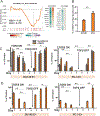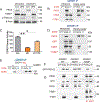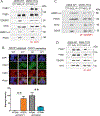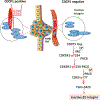Regulation of inside-out β1-integrin activation by CDCP1
- PMID: 29511352
- PMCID: PMC6824599
- DOI: 10.1038/s41388-018-0142-2
Regulation of inside-out β1-integrin activation by CDCP1
Abstract
Tumor metastasis depends on the dynamic regulation of cell adhesion through β1-integrin. The Cub-Domain Containing Protein-1, CDCP1, is a transmembrane glycoprotein which regulates cell adhesion. Overexpression and loss of CDCP1 have been observed in the same cancer types to promote metastatic progression. Here, we demonstrate reduced CDCP1 expression in high-grade, primary prostate cancers, circulating tumor cells and tumor metastases of patients with castrate-resistant prostate cancer. CDCP1 is expressed in epithelial and not mesenchymal cells, and its cell surface and mRNA expression declines upon stimulation with TGFβ1 and epithelial-to-mesenchymal transition. Silencing of CDCP1 in DU145 and PC3 cells resulted in 3.4-fold higher proliferation of non-adherent cells and 4.4-fold greater anchorage independent growth. CDCP1-silenced tumors grew in 100% of mice, compared to 30% growth of CDCP1-expressing tumors. After CDCP1 silencing, cell adhesion and migration diminished 2.1-fold, caused by loss of inside-out activation of β1-integrin. We determined that the loss of CDCP1 reduces CDK5 kinase activity due to the phosphorylation of its regulatory subunit, CDK5R1/p35, by c-SRC on Y234. This generates a binding site for the C2 domain of PKCδ, which in turn phosphorylates CDK5 on T77. The resulting dissociation of the CDK5R1/CDK5 complex abolishes the activity of CDK5. Mutations of CDK5-T77 and CDK5R1-Y234 phosphorylation sites re-establish the CDK5/CDKR1 complex and the inside-out activity of β1-integrin. Altogether, we discovered a new mechanism of regulation of CDK5 through loss of CDCP1, which dynamically regulates β1-integrin in non-adherent cells and which may promote vascular dissemination in patients with advanced prostate cancer.
Conflict of interest statement
Figures








Similar articles
-
In vivo cleaved CDCP1 promotes early tumor dissemination via complexing with activated β1 integrin and induction of FAK/PI3K/Akt motility signaling.Oncogene. 2014 Jan 9;33(2):255-68. doi: 10.1038/onc.2012.547. Epub 2012 Dec 3. Oncogene. 2014. PMID: 23208492 Free PMC article.
-
CUB-domain-containing protein 1 overexpression in solid cancers promotes cancer cell growth by activating Src family kinases.Oncogene. 2015 Oct 29;34(44):5593-8. doi: 10.1038/onc.2015.19. Epub 2015 Mar 2. Oncogene. 2015. PMID: 25728678 Free PMC article.
-
CUB domain-containing protein 1, a prognostic factor for human pancreatic cancers, promotes cell migration and extracellular matrix degradation.Cancer Res. 2010 Jun 15;70(12):5136-46. doi: 10.1158/0008-5472.CAN-10-0220. Epub 2010 May 25. Cancer Res. 2010. PMID: 20501830
-
Roles of CUB domain-containing protein 1 signaling in cancer invasion and metastasis.Cancer Sci. 2011 Nov;102(11):1943-8. doi: 10.1111/j.1349-7006.2011.02052.x. Epub 2011 Sep 6. Cancer Sci. 2011. PMID: 21812858 Review.
-
The CDCP1 Signaling Hub: A Target for Cancer Detection and Therapeutic Intervention.Cancer Res. 2021 May 1;81(9):2259-2269. doi: 10.1158/0008-5472.CAN-20-2978. Epub 2021 Jan 28. Cancer Res. 2021. PMID: 33509939 Review.
Cited by
-
KRAS and BRAF mutations induce anoikis resistance and characteristic 3D phenotypes in Caco‑2 cells.Mol Med Rep. 2019 Nov;20(5):4634-4644. doi: 10.3892/mmr.2019.10693. Epub 2019 Sep 20. Mol Med Rep. 2019. PMID: 31545494 Free PMC article.
-
The Role of CDK5 in Tumours and Tumour Microenvironments.Cancers (Basel). 2020 Dec 31;13(1):101. doi: 10.3390/cancers13010101. Cancers (Basel). 2020. PMID: 33396266 Free PMC article. Review.
-
Effect of VX‑765 on the transcriptome profile of mice spinal cords with acute injury.Mol Med Rep. 2020 Jul;22(1):33-42. doi: 10.3892/mmr.2020.11129. Epub 2020 May 5. Mol Med Rep. 2020. PMID: 32377730 Free PMC article.
-
Substrate-biased activity-based probes identify proteases that cleave receptor CDCP1.Nat Chem Biol. 2021 Jul;17(7):776-783. doi: 10.1038/s41589-021-00783-w. Epub 2021 Apr 15. Nat Chem Biol. 2021. PMID: 33859413
-
Loss of CDCP1 triggers FAK activation in detached prostate cancer cells.Am J Clin Exp Urol. 2021 Aug 25;9(4):350-366. eCollection 2021. Am J Clin Exp Urol. 2021. PMID: 34541033 Free PMC article.
References
-
- Wortmann A, He Y, Deryugina EI, Quigley JP, Hooper JD. The cell surface glycoprotein CDCP1 in cancer—insights, opportunities, and challenges. IUBMB Life. 2009;61:723–30. - PubMed
-
- Siva AC, Kirkland RE, Lin B, Maruyama T, McWhirter J, Yantiri-Wernimont F, et al. Selection of anti-cancer antibodies from combinatorial libraries by whole-cell panning and stringent subtraction with human blood cells. J Immunol Methods. 2008;330:109–19. - PubMed
-
- Siva AC, Wild MA, Kirkland RE, Nolan MJ, Lin B, Maruyama T, et al. Targeting CUB domain-containing protein 1 with a monoclonal antibody inhibits metastasis in a prostate cancer model. Cancer Res. 2008;68:3759–66. - PubMed
Publication types
MeSH terms
Substances
Grants and funding
LinkOut - more resources
Full Text Sources
Other Literature Sources
Molecular Biology Databases
Research Materials
Miscellaneous

